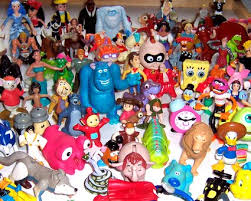Furthermore, junk food
advertisement can lead to children’s obesity. Berkley
Media Studies Group in California found that of the 77 foods advertised, only 5
were actually healthy options. And numerous studies
have shown that children exposed to food advertising prefer and choose
advertised food products more frequently than those not exposed to such ads. This
means that there is a higher chance to eat unhealthy food, such as fastfood.
Fast food chains spend more than 3 billion dollars a year on advertising, much
of it aimed at children. A 2002 US study showed that fast food commercials during
kids programming on Saturday morning are pitching bigger and bigger portions, a
trend that researchers link to an the alarming rise of obesity among young
people. To directly target children, they offer playgrounds, contests, clubs,
games, and free toys and other merchandise related to movies, TV shows and even
sports leagues.San Francisco, a little while after, passed the law that the toy
the fast food market gives to attract the children should be bought with money
because many children buy fast food because they want to have that toy. In
fact, according to the U.S. Centers for Disease Control and Prevention, more
than one in six children and teenagers were obese and the obesity rate from
2003 to 2011, has increased 3 times. Also, according to Heart and Stroke
foundation of Canada - says that 1 in 4 Canadian children between 7 and 12 is
obese. To prevent more child obesity,
advertisement should be banned. The recent study showed that the banning on
junk food advertisement geared towards children could reduce child obesity and
the number of overweight children ages 6-11 by 18 percent. Thus, advertising
geared toward children should be banned.
2012년 5월 19일 토요일
Children advertisement
First, hildren
are not mature enough to understand how they are targeted and how advertising
works on their mind and purchasing behavior. Recent research, ‘Television
viewing and aggressive behavior during adolescence and adulthood’, shows that
children aged five to ten are not able to tell the difference between regular
TV programs and commercials. This means that they do not even understand that
advertisements are there to sell their products, and they tend to believe what
they are shown on TV commercials is true. Actually
the Canadian toy testing council said that the biggest area of concern with toy
ads in Canada is exaggeration. Therefore, young children often think a toy can
do a lot more than it can because of the way toys are portrayed in
advertisement. So, Quebec city in Canada has banned print and broadcast advertising
aimed at kids under 13. There are other several tactics used by advertisers,
which is difficult for children to detect. For example, advertisers make a
frequent use of weasel words which sound informative, but actually mean
nothing. Thus, because children are not mature to understand the advertisement,
advertising geared toward childre should be banned

피드 구독하기:
댓글 (Atom)
댓글 없음:
댓글 쓰기